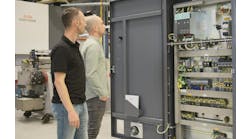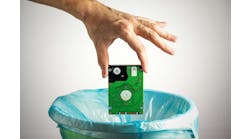Simulation is defined as an imitation of a situation or process. What we would have given to be able to test our PLC and HMI code against a simulated process to find all the bugs and process errors.
Back one Christmas in 1989, I was creating the code for a vessel jacket-heated process in the manufacturing of gum. I can’t remember how many ingredients there were, but there were liquid and granular product that were to be mixed for a certain time at a certain temperature before discharge into the process.
Where I ran into a brick wall was the loop tuning on the jacket temperature. The first ingredient was liquid, which was brought up to temperature before the other products were added. The other liquid components were cold, so that when they were added—a major disturbance—the tank temperature dropped like a rock. The resulting jacket temperature control system jacked the temp up way too high and ruined the batch. It only happened once, but you can imagine my surprise that this disturbance created such a major issue.
If I had been able to simulate the process in software back in the good old days, I would have found this problem based upon tank volume, jacket temperature transfer function and product temperatures. The tuning algorithms could have been detailed before the actual process was controlled.
Also read: System design tools make simulation real
Fast forward to 2021. We have the tools to simulate almost anything, but for small one-off projects the effort may not be worthwhile. Project development usually is driven by the process or chemical engineers for process and by mechanical engineers for machine builders. A design document—functional requirements document (FRD)—or specification is the result of this action.
In machine-control applications, PLC-code development takes place along with the HMI, and then the system is emulated to prove the HMI connections, as well as the PLC program, flow as such. This is not the same as simulation.
Let’s assume that the process is a standard drill station. The PLC code can be written based on the FRD and the HMI developed based on the PLC code and required screens. Testing of this automation pair can be done easily using emulation. But this does not take into account such things as conveyor speeds, distances between stations, cycle time and operator interfacing with the process.
Simulation of the drill station would take these properties into account, and then the PLC/HMI code can be tested against the simulation. This is where the control narrative can be proven so that when the real install occurs you have massaged the code to match the process.
However, the strength of the system code is only as good as the simulation model, so time and effort—which equal cost—need to be put into the simulation platform, which based on my experience isn’t for the faint of heart.
The benefits of simulation hopefully are obvious.
Imagine developing a distillation column and your control narrative was all wrong, which would have been proven with simulation. That’s a very dangerous situation.
Process simulation can incorporate many facets of your business including predictive maintenance, tool crib functionality, SOPs and process operation, machine functionality, interfacing of various production line components and the like.
When I first started in the automation business many moons ago, we needed PLC hardware and HMI hardware to test an installation before actually installing it into the system. Again, all we could do was emulate the I/O manually to test the functionality at a basic level. The real test was when the PLC was wired in with the real I/O and the dynamics of the system were observed.
I engineered an extruder line for a tier 2 supplier in automotive. The application was built and wired with a minimum of documentation. When I arrived on-site I was flying by the seat of my pants. Not the best situation but I created the FRD so that I could understand the process and the operational requirements.
There was loop tuning and discrete control along with HMI design to consider. I was living in Houston at the time, so I had to land on my feet.
Simulation would have allowed me to understand the process first, write the code against the simulation, which would have taken the commissioning from many weeks—there were mechanical design issues—to many days.
While simulation may take additional resources and time/effort, in certain situations it can make your life a lot easier. Consider it for your next project, especially if your last one didn’t go so well.






